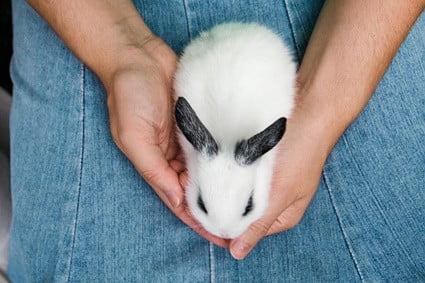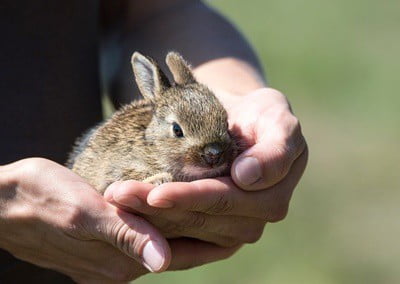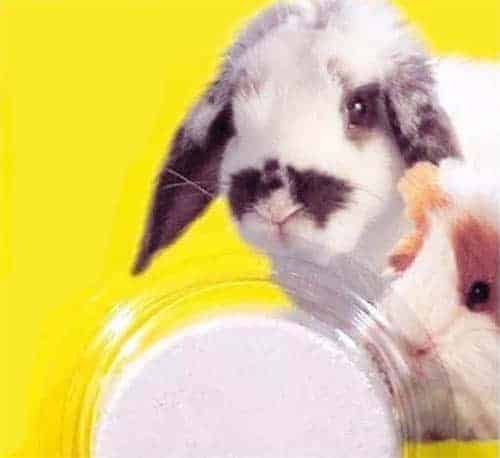Salt is a vital part of your rabbit’s diet, so you’re likely wondering if your pet needs a sodium chloride supplement to stay healthy. One of the ways to achieve this dietary requirement is by providing a salt and mineral lick.
Rabbits that are fed high-quality feed don’t need salt or mineral licks. Foods contain the salt and minerals that rabbits need to stay healthy. Domesticated rabbits know how to regulate their salt intake and will only use the salt lick if their diet isn’t optimal for their needs.
Salt is necessary for any animal’s diet, but it must be consumed in moderation. If you decide to get a salt or mineral lick, your rabbit will instinctively know when its body needs additional salt.
Do Rabbits Have Salt Licks?
Salt is important for a rabbit’s nerves, muscles, and fluid regulation. So, all rabbits need to get enough salt. More often than not, your rabbit does not need a salt lick, though. That is, provided that it is fed the right diet.
The same is true for mineral licks. All specialized rabbit foods should contain the minerals that a rabbit needs in the right quantities.
How Much Sodium Do Rabbits Need?
Salt performs multiple functions in a rabbit’s body. However, there aren’t many studies that have looked into the amount of salt that a rabbit needs each day. However, according to the National Research Council, up to 0.5% of a rabbit’s daily diet will consist of salt.
Rabbits instinctively know when to increase their sodium intake, according to Physiology and Behavior. To regulate a rabbit’s salt intake, it will increase its sodium chloride level through additional food consumption.

What’s The Purpose of Salt Licks for Rabbits?
Before the days of store-bought pellets, owners would feed rabbits a diet that they had formulated. These would often be an all-natural diet that contained little or no sodium. Salt licks were used to address this dietary imbalance. Today, pellet feed contains all the minerals that rabbits need.
Ideally, a natural diet would have all the minerals that rabbits need. However, the levels of minerals in each plant vary considerably. The factors that affect mineral levels in plants include soil quality, farming techniques, and the external environment like temperature and humidity.
Wild rabbits get the sodium that they need from rocks. Rocks have salt on their surfaces, and rabbits will lick them to address their need for sodium. Additionally, wild rabbits have a larger choice of foods available to them.
How To Make a Salt Lick for Rabbits
Here’s what’s needed to make a salt lick:
- Rock salt
- Bone meal
- Clay
- Molasses (optional, for sweetening)
- Lime (optional, for added hardening)
- Large wooden spoon or stick
- Cardboard box
- Trash bag
- Hook or rope (optional)
Here are the steps for making a DIY salt lick for rabbits:
- You will need 2 parts of rock salt, 4 parts of bone meal, and 1 part of clay. Add water to the bowl to incorporate all ingredients.
- If you want a solid mixture, add lime at this stage. The amount of lime will vary depending on how solid you want the salt lick to be. Begin with a teaspoon at a time and gauge the result.
- Add more water until it becomes a thick paste. You’ve reached the right consistency if the mixture can easily be molded with a spoon.
- Just before all the water has been incorporated, add the molasses.
- To make your salt lick long-lived and less prone to breakage, drain the water. To do this, mold the mixture so you can squeeze the excess water from it. Drain the water. Repeat until all the water has been drained. This may take several minutes.
- Line a pan with a trash bag. Pour the mixture into this container.
- Place the box in a cool, dry place. Attach a hook or rope before it hardens so that can be used to hang the salt lick in your rabbit’s hutch.
- Allow it to harden for at least 2 weeks.
Can Rabbits Get Too Much Salt?
Rabbits know when they have had enough salt. They regulate their levels when they have had too much, according to the Journal of Physiology.
Rabbits that have consumed an excessive amount of salt will drink more water to reduce their salt levels. With more water in their systems, the salt in their bodies will be diluted. Rabbits will expel this excess salt through their urine and feces.
Do Rabbits Lick for Salt or Affection?
Rabbits show their affection through grooming. When a rabbit is comfortable with another rabbit, you will often see one rabbit licking the other. This extends to rabbits licking their owners.
If your rabbit licks you, it’s not because it’s looking for salt. Instead, your rabbit is saying, ‘I love you.’
Aside from showing affection, licking is a way to solicit attention. A rabbit-lick may be asking for loving pets or for playtime. Whatever the cause, if your rabbit is licking you, it’s always a good idea to return its affection.
Do Rabbits Like Salt Licks?
Rabbits know when they are lacking in salt or other minerals. As such, rabbits often enjoy salt licks as a way to fill a gap left by their diet or specific body chemistry. If your rabbit has a well-balanced diet, it will probably ignore salt licks until it has a sodium deficiency.
However, each rabbit is different and may pursue a salt lick for reasons other than nutritional necessity. For example, some rabbits may use a salt lick because they like the taste. Others may see it as a treat. Other rabbits may also treat it like a good toy to play with.
Your rabbit may be picky. Even if it needs sodium, it may refuse the salt lick or ignore it. This may be a result of the salt lick’s smell, taste, or texture. If this happens, you can rotate through different types of salt lick, until you find one that your rabbit appreciates. Otherwise, you can try feeding your rabbit salt-rich foods to compensate for the gap in its diet.
Do Rabbits Need Mineral Blocks?
Mineral blocks are made of different trace minerals. These include copper, zinc, manganese, and iodine, on top of the sodium chloride present in salt. Your rabbit doesn’t need mineral blocks if it is fed a quality feed.
According to Nutrition and Digestive Physiology, rabbits provided with mineral blocks gain more weight. Rabbits with mineral blocks weighed 188 grams more than rabbits that did not have mineral blocks. The researchers theorized that this is because of higher levels of calcium.
Salt Licks vs. Mineral Blocks
When looking at salt and mineral blocks, you may notice that there are more products labeled as salt licks.
Most of these products have added minerals in their formulation. This technically makes them mineral blocks. But, because products made purely of salt are uncommon, the difference in terminology becomes moot.
The best way to determine what it contains is to look at the ingredients list. Most products will contain additional minerals. However, you may still find salt licks that only contain sodium chloride.
Why Do Rabbits Need Salt Licks?
Salt licks are intended to address a shortfall in a rabbit’s dietary needs. Here are some of the functions of salt licks:
Nutritional Needs
All animals need sodium in their diet, but some diets do not have adequate salt content. This often occurs in diets that consist of plants and grass hays.
Salt contains many different minerals and nutrients. The function includes balancing electrolytes, and regulating blood pressure and fluids in the body.

Avoid Boredom
Rabbis may need salt licks for enrichment. Rabbits need objects to interact with to keep them entertained. Salt licks can be a source of entertainment.
Wear Down Teeth
Rabbits are prone to problems with their teeth, which can lead to complications. A salt lick can help to wear down teeth.
When getting a salt lick, the first thing to consider is its ingredients. Not all salt licks are quite the same. Some are made purely with salt, but most have minerals added to them. Check the ingredients list in order to be sure.
Look at the calcium content. Calcium is an important part of any rabbit’s diet. However, too much calcium can result in kidney stones. Medium-sized rabbits should only consume 510mg of calcium per day, for example.
Consider is how the salt lick should be put in your rabbit’s hutch. Some salt licks provide hangers, clips, and strings for easy attachment.

